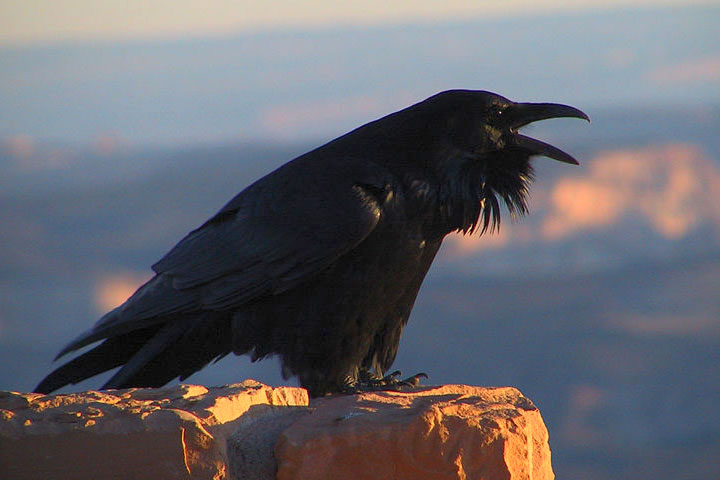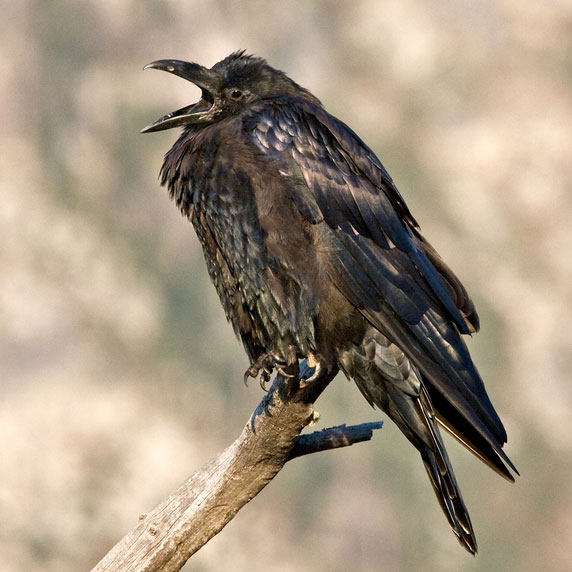

|
Common Raven (Corvus corax) Description: The Common Raven, the largest of the passerines (perching birds), is found across all of the United States and most of Canada. The raven is all black, has a 4 ft wingspan and is over two feet from head to tail. The sexes are generally alike, although females may be smaller. The raven is often misidentified as a crow - a closely related bird.
Mass: 689 to 1625 g; avg. 1157 g Length: 43 cm (24 in) Wingspan: 1.3 m (48 in) 
What is the difference between a crow and a raven? Ravens are uncommon in populated urban areas. If you see a "really big crow" in the city, the chances are good that it really is a crow and not a raven. Common ravens have a well-developed ruff of feathers on the throat, which are called 'hackles' (see photo). Ravens soar more than crows. If you see a "crow" soaring for more than a few seconds, take another look - it might be a raven. Common Ravens can do a somersault in flight and even fly upside down. Ravens are longer necked in flight than crows. Raven wings are shaped differently than are crow wings, with longer primaries ("fingers") with more slotting between them. Ravens have wedge-shaped tails and crows have fan-shaped tails (view drawing). See a side-by-side comparison of Ravens and Crows Calls: The common raven makes a variety of calls including these sounds: "croooaaak", "cr-r-ruck", "tok", and "wonk-wonk" The typical crow call is a loud "caw". The call is often vocalized in a repeating series - "caw caw caw ". Listen to calls of this species » Range / Habitat: Ravens and crows can be found in a variety of different habitats, though they generally prefer open and partially open areas. They are commonly found on tidal flats, in agricultural fields and orchards, riparian forests (forests along the edge of a lake or stream), on savannas, and in suburban areas. They avoid dense forests, where they are more vulnerable to predators. Typically, you will not find ravens and crows in the same area. The Common Raven is one of the most widespread birds in the state of Washington. Ravens can survive equally well in dense forests, alpine parkland, and sagebrush areas, though they are rare or absent in most cities (though apparently now breeding in Stanley Park, Vancouver, BC). Click the range map to learn more about the distribution of Common Ravens in Washington. Diet: Ravens like to feed in open areas, and sometimes forage and catch food cooperatively. Common ravens are mainly scavengers. They eat a wide array of animal foods, including arthropods, amphibians, small mammals, birds, reptiles, and carrion. They are attracted to carrion and eat also the insects that feed on carrion (chiefly on maggots and beetles). Ravens are not picky eaters - they will eat human trash, and if hungry enough they consume mammal dung. 
Nesting: Common ravens generally roost on cliff ledges or in large trees but have also established nests on power-lines, in urban areas, and on billboards. Their nests are cup shaped and made of twigs. A female raven will lay 3 - 7 eggs in the nest and incubates them for about 18 days. The male and the female will both tend to their young. Young leave the nest between 5 and 7 weeks of age. They sometimes disperse or may stay in the area where they were born. Sexual maturity is reached at about 3 years of age. Behavior: Although it is not widely known, the common raven is one of the most intelligent of all birds. The raven's intelligence is apparent in its ability to communicate a wide range of messages through its call. It can communicate warning, threat, taunting, and cheer to other birds by varying the sound it makes. Over 20 distinct patterns of calls have been interpreted by researchers. The Corvids - crows, ravens, jays, magpies and jackdaws - are sometimes called the Einsteins of the bird family. Few other birds come close to matching their intelligence. Common ravens move around by walking on the ground or flying. Ravens also glide and soar in the air, which they do more often than crows. Lifespan/Longevity: A wild raven was recorded living for over 13 years. A lifespan of 6 to 10 years is the norm since there is a mortality rate of about 50 percent in the first year. Captive birds may live much longer - one captive crow in New York, named Tata, was recorded to have lived for 59 years! Predators: Ravens and crows have few predators - eagles, hawks, owls, and human hunters. Humans are their main predator. Did you know?
Raven Photos: Common Ravens Photo Gallery by Paul Lantz Ravens (Corvus corax) in Moosonee, Ontario More information: How to identify Crows and Ravens Crows - WDFW Living with Wildlife Frequently Asked Questions about Crows - Dr. Kevin J. McGowan, Cornell University. Raven - Bryce Canyon National Park Further Reading: Bent, Arthur Cleveland. 1964. Life Histories of North American Jays, Crows and Titmice vol 1. Dover Publications Inc. New York, N.Y. Erlich, Paul R. et al. 1988. The Birder's Handbook: a field guide to the natural history of North American Birds, Simon and Schuster/Fireside Books, New York Heinrich, Bernd. 1989. Ravens in Winter. Summit Books, New York, NY Kilham, Lawrence. The American Crow and the Common Raven. Savage, Candace. Bird brains: The intelligence of crows, ravens, magpies, and jays. Animal silhouettes available to purchase » Photos/Drawing: NPS, Christian Petersen, Natures Pics, WDFW Home | About Us | How to Participate | Biodiversity Modules | Projects | Maps | News | Resources |